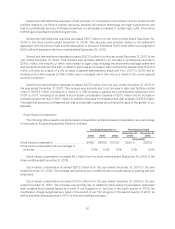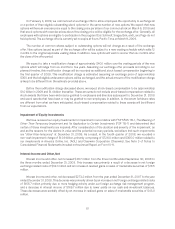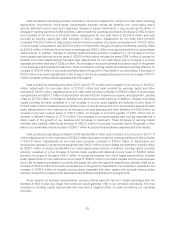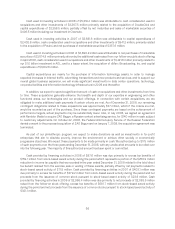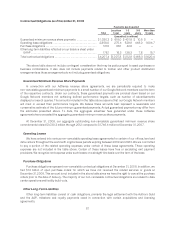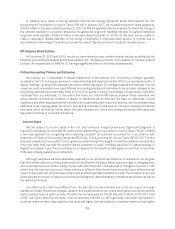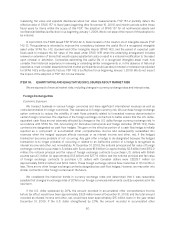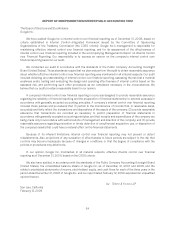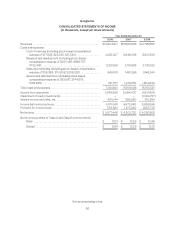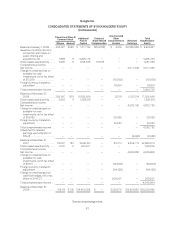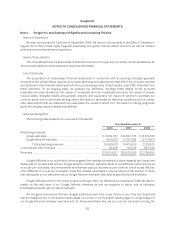Google 2008 Annual Report Download - page 76
Download and view the complete annual report
Please find page 76 of the 2008 Google annual report below. You can navigate through the pages in the report by either clicking on the pages listed below, or by using the keyword search tool below to find specific information within the annual report.measuring fair value and expands disclosures about fair value measurements. FSP 157-2 partially defers the
effective date of SFAS 157 to fiscal years beginning after November 15, 2008, and interim periods within those
fiscal years for items within the scope of this FSP. The adoption of SFAS 157 for all nonfinancial assets and
nonfinancial liabilities is effective for us beginning January 1, 2009. We do not expect the impact of this adoption to
be material.
In April 2008, the FASB issued FSP SFAS 142-3, Determination of the Useful Life of Intangible Assets (FSP
142-3). This guidance is intended to improve the consistency between the useful life of a recognized intangible
asset under SFAS No. 142, Goodwill and Other Intangible Assets (SFAS 142), and the period of expected cash
flows used to measure the fair value of the asset under SFAS 141R when the underlying arrangement includes
renewal or extension of terms that would require substantial costs or result in a material modification to the asset
upon renewal or extension. Companies estimating the useful life of a recognized intangible asset must now
consider their historical experience in renewing or extending similar arrangements or, in the absence of historical
experience, must consider assumptions that market participants would use about renewal or extension as adjusted
for SFAS 142’s entity-specific factors. FSP 142-3 is effective for us beginning January 1, 2009. We do not expect
the impact of the adoption of FSP 142-3 to be material.
ITEM 7A. QUANTITATIVE AND QUALITATIVE DISCLOSURES ABOUT MARKET RISK
We are exposed to financial market risks, including changes in currency exchange rates and interest rates.
Foreign Exchange Risk
Economic Exposure
We transact business in various foreign currencies and have significant international revenues as well as
costs denominated in foreign currencies. This exposes us to foreign currency risk. We purchase foreign exchange
option contracts to reduce the volatility of cash flows primarily related to forecasted revenue denominated in
certain foreign currencies. The objective of the foreign exchange contracts is to better ensure that the U.S. dollar-
equivalent cash flows are not adversely affected by changes in the U.S. dollar/foreign currency exchange rate. In
accordance with SFAS No. 133, Accounting for Derivative Instruments and Hedge Activities (SFAS 133), these
contracts are designated as cash flow hedges. The gain on the effective portion of a cash flow hedge is initially
reported as a component of accumulated other comprehensive income and subsequently reclassified into
revenues when the hedged exposure affects revenues or as interest income and other, net, if the hedged
transaction becomes probable of not occurring. Any gain after a hedge is de-designated because the hedged
transaction is no longer probable of occurring or related to an ineffective portion of a hedge is recognized as
interest income and other, net, immediately. At December 31, 2008, the notional principal and fair value of foreign
exchange contracts to purchase U.S. dollars with Euros were €1.9 billion (or approximately $2.6 billion) and $152.0
million; the notional principal and fair value of foreign exchange contracts to purchase U.S. dollars with British
pounds were £1.1 billion (or approximately $1.8 billion) and $277.9 million; and the notional principal and fair value
of foreign exchange contracts to purchase U.S. dollars with Canadian dollars were C$229.7 million (or
approximately $202.2 million) and $21.9 million. These foreign exchange options have maturities of 18 months or
less. There are no other foreign exchange contracts designated as cash flow hedges. However, we may enter into
similar contracts in other foreign currencies in the future.
We considered the historical trends in currency exchange rates and determined that it was reasonably
possible that changes in exchange rates of 20% for our foreign currencies instruments could be experienced in the
near term.
If the U.S. dollar weakened by 20%, the amount recorded in accumulated other comprehensive income
before tax effect would have been approximately $325 million lower at December 31, 2008, and the total amount
recorded as interest income and other, net, would have been approximately $15 million lower in the year ended
December 31, 2008. If the U.S. dollar strengthened by 20%, the amount recorded in accumulated other
60


